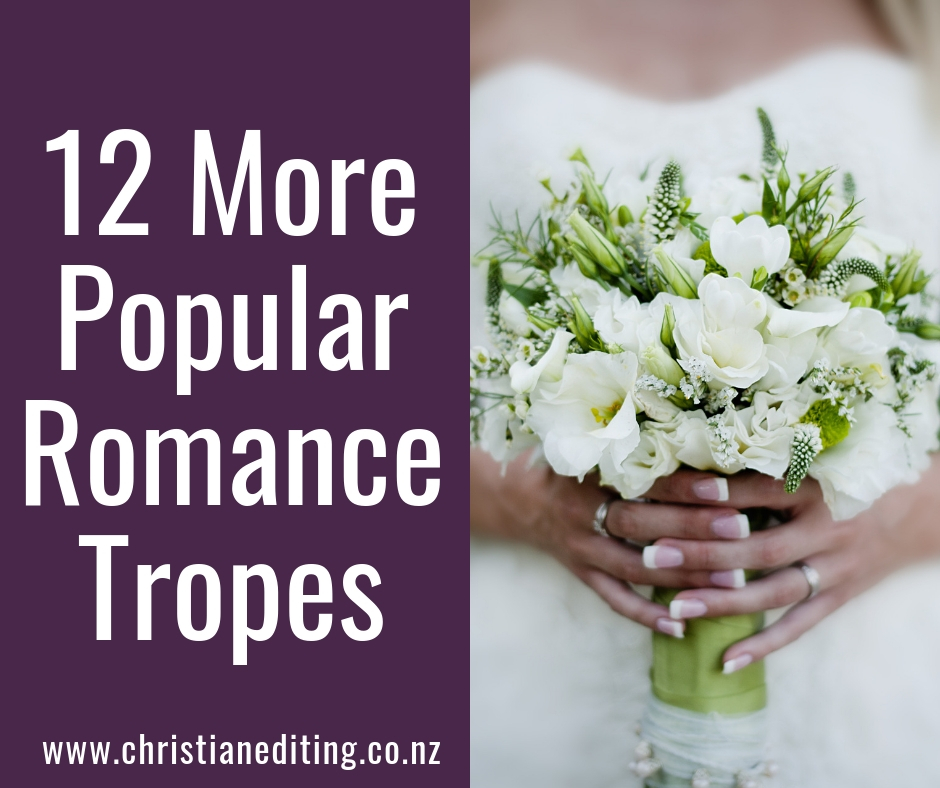Last week, I introduced the concept of tropes, and discussed ten popular romance tropes.
Today I’m introducing more popular romance tropes, and giving some examples.
Best Friend’s Sibling
The hero falls for his best friend’s (usually younger) sister, or the heroine falls for her best friend’s (usually older) brother.
This is similar to the Friends to Lovers trope, as the hero and heroine usually have a preexisting relationship through the best friend/sibling. The two often get together after one returns to their hometown (e.g. during an illness, after the death of a family member, after a relationship or marriage breakup, or after serving in the armed forces).
Ugly Duckling
The unattractive heroine finds true love after undergoing a makeover and emerging as a physical beauty.
This can be a difficult trope to make work as a writer, especially as a Christian writer. Readers don’t want to read about a hero who is so shallow that he isn’t interested in the heroine except for her looks, which means the hero needs to see and want a relationship with the heroine even before her transformation.
While the Ugly Duckling is usually the heroine, the story could be twisted so the hero gets the makeover, as in the show Beauty and the Geek. However, the same challenges still stand: readers are not going to relate to a heroine who doesn’t value the inner man.
Other Man/Other Woman
This is similar to the Love Triangle. The hero and heroine meet and start a relationship, which is disrupted by the reapperance of an ex. This could be an ex-girlfriend or ex-boyfriend, an ex-fiance, or an ex-spouse. The ex makes it clear they want to get back together, which often scares off the current partner. The main character has to chase off the ex and convince their new love that the ex is history.
The challenge with this trope is similar to that of the Love Triangle: if the OM/OW is a likeable character, then some readers will want them to get back together. But if the OM/OW isn’t likeable, the readers wonder why they got together in the first place and question the judgement of the heroine/hero for ever being with that person (especially as the OM/OW often ends up being a cheater, drug addict, or other miscreant).
Example: Central to Nowhere by DJ Blackmore
(One tip I’ve heard for authors writing Other Woman: don’t make her completely unlikeable, because your readers and publisher might decide she needs to be the heroine in your next book.)
Marriage of Convenience
The hero and heroine agree to marry out of necessity, then fall in love. This is a common trope in historical fiction, where it can be that the couple are brought together by tragic circumstance (e.g. a widower wants a mother for his children) or forced together by awkward circumstances and cultural norms (e.g. in Victorian times, couples who spent time alone together without a suitable chaperone were often forced to marry to protect her reputation. Or, at least, that’s what fiction would have us believe).
Example: Love Comes Softly by Janette Oke
Secret Romance
The hero and heroine meet and start a relationship, but keep it secret from friends and family for some reason. This isn’t such a popular trope in Christian romance, probably because Christian readers don’t like to see characters lying to each other or to their family and friends without good reason.
Example: Romeo and Juliet
Love at First Sight
The hero and heroine meet, fall in love, and live happily ever after. In real life, some people believe in love at first sight, but others say it’s not possible: that love is a choice, or that love grows as two people develop their relationship. They say love at first sight is attraction at best (and more likely lust), as we can’t truly love someone we don’t know. As such, Love at First Sight has to be managed carefully in Christian romance.
Reunited Lovers
A couple are separated by forces outside their control—overbearing parents, an accident, a war. In some historical romances, one character travels (e.g. to America), promising to send for the other but something goes wrong. Anyway, the two meet again, years later, and have the opportunity to rekindle their relationship.
Trapped
Two strangers are trapped together in an elevator or a snowstorm (or anything that forces the hero and heroine to spend time together with no interruptions). They form a relationship, continue that relationship after they are rescued, and live happily ever after.
Example: Danger in the Shadows by Dee Henderson
Mail Order Bride
Mail order bride stories are typically set in the American West, between 1870 and 1900. Women were scarce, so men would advertise for brides, correspond with them, then pay their train fares from some eastern city to the West. As such, it’s a marriage of two almost-strangers in the nineteenth century of online dating.
Example: Escape to the West series by Nerys Leigh
Opposites Attract
Two people who appear to be polar opposites are attracted to each other, and have to work out if their relationship can overcome their differences. This is a popular trope, as opposites give instant conflict … which means plenty of external tension.
Example: Then There Was You by Kara Isaac
Bad Girl/Boy
The “good” character (often the heroine) is attracted to someone her parents or friends consider to be an inappropriate choice—the “bad boy”. This gives two levels of conflict—the hero may have to convince the heroine he’s “good enough” (or vice versa), and they both have to convince others that their relationship can succeed despite their differences.
Example: The Masterpiece by Francine Rivers
Soul Mate
The hero and heroine are destined to be together by fate/the gods/some other external and usually supernatural force. If either the hero or heroine is in any other relationship, it is destined to fail. The Soul Mate trope is common in urban fiction or paranormal romance, where it seems that all good werewolves and many other werebeings readily accept that they are somehow supernaturally linked to one other being.
This is an uncommon trope in Christian fiction, perhaps because it shows a preference for predestination vs. free will, and modern Christian fiction tends to avoid such theological questions.
Conclusion
The advantage of using tropes is that readers are familiar with them and often have favourite tropes they will read over and over. The disadvantage of using tropes is that readers are familiar with them, and can become bored because the trope is too predictable.
One solution to this problem is to twist tropes (e.g. have a male Ugly Duckling), or use multiple tropes. Many of the tropes do work well together. For example, a Fake Romance may be coupled with a Belated Epiphany, where the fake relationship comes to an agreed end, then one main character realises s/he actually does love the other.


